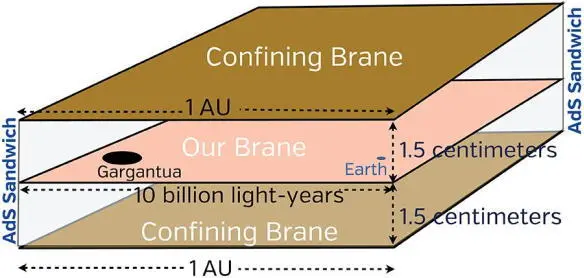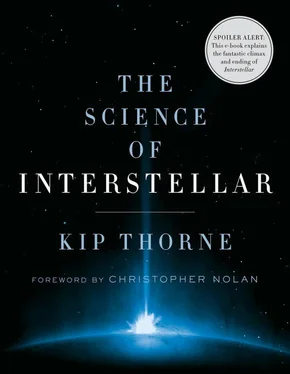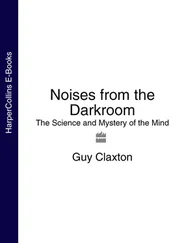
Sadly, the precipitous shrinkage of distances parallel to our brane, as you move outward, makes the bulk’s volume above and below our brane too small for Cooper and his tesseract, and too small for any other human activity in the bulk. I recognized this problem way back in 2006, when Interstellar was in its infancy, and I quickly conceived a solution for my science interpretation of the movie: Confine the AdS warping to a thin layer around our brane, a “sandwich.” Do so by placing two other branes, confining branes, alongside ours (Figure 23.7). In the sandwich between these branes, the bulk suffers AdS warping. Outside the sandwich, the bulk is totally unwarped. So there is all the volume any sci-fi writer could want, outside the sandwich, for bulk-based adventures.
How thick must the sandwich be? Thick enough to bend gravitational force lines—emerging from our brane—parallel to our brane and hold them there, so we in our brane see gravity obey an inverse square law. But no thicker, because added thickness means greater total transverse shrinkage, which may cause trouble for bulk-based adventures. (Suppose our whole universe, as seen from outside the AdS layer, were shrunk to the size of a pin head!) The required thickness turns out to be about 3 centimeters (roughly an inch), so as you travel from our brane to a confining brane, distances parallel to our brane shrink by fifteen powers of ten: a thousand trillion.

Fig. 23.7. The AdS sandwich between two confining branes. The AdS layer between the branes is lightly grayed.
In my interpretation of Interstellar , Gargantua is in the far reaches of the observable universe: roughly 10 billion light-years from Earth. Cooper, in the tesseract, rises through the AdS layer, from Gargantua’s core into the bulk. There the distance to Earth is 10 billion light-years divided by a thousand trillion, which is about the same as the distance between the Sun and the Earth, one “astronomical unit” (1 AU; Figure 23.7). Cooper then travels that 1 AU distance through the bulk, parallel to our brane, to reach the Earth and visit Murph; see Figure 29.4.
DANGER: The Sandwich Is Unstable

In 2006, I used Einstein’s relativistic laws to work out a mathematical description of the AdS layer and its confining branes. Because I had never before worked with relativity in five dimensions, I asked Lisa Randall to critique my analysis. Lisa browsed it quickly, and then told me some good news and some bad news.
The good news: My idea of an AdS sandwich had been invented six years earlier by Ruth Gregory (University of Durham, UK), together with Valery Rubakov and Sergei Sibiryakov (Institute for Nuclear Research in Moscow, Russia). This showed I was not being stupid in my first mathematical foray into the bulk. I had rediscovered something worth discovering.
The bad news: Edward Witten (Princeton) and others had shown that the AdS sandwich is unstable! The confining branes are under pressure, rather like a playing card that you squeeze end to end between your finger and thumb (Figure 23.8). The card bends, and with further squeezing, it buckles. Similarly, the confining branes will bend and crash into our brane (our universe), destroying it. The entire universe destroyed! That’s the worst news ever!!
But I can think of several ways to save our universe, if it really does live in an AdS sandwich (which I very much doubt it does); several ways to “stabilize the confining branes,” in the jargon of physicists.
In my science interpretation of Interstellar , Professor Brand, working with Einstein’s relativity equations, rediscovers the AdS sandwich, as I did; see the photograph of his blackboard in Figure 3.6. How the confining branes are stabilized then gets intertwined with the Professor’s struggle to understand and control gravitational anomalies. In the movie, that struggle is spelled out mathematically on the sixteen blackboards in Professor Brand’s office; Chapter 25.

Fig. 23.8. A playing card, compressed end to end, bends and then buckles.
Traveling Through the AdS Layer

In the AdS layer, the AdS warpage of space produces tidal forces that are enormous by human standards. Any bulk being traveling through the layer to reach our brane must deal with those forces. Because we know nothing about the matter of which a bulk being is made—matter with four space dimensions—we have no idea whether this is an issue. In science fiction it can be left in the hands of the writers.
Not so for Cooper, riding in the tesseract (Chapter 29). In my interpretation of the movie, he has to cross the AdS layer. The tesseract must either protect him from the layer’s enormous tidal forces or clear the AdS layer away from his path. Otherwise he’ll be spaghettified.
By confining gravity, the AdS layer regulates its strength. In Interstellar we see gravity’s strength fluctuate, perhaps due to fluctuations in the AdS layer. These fluctuations—gravitational anomalies—play a huge role in Interstellar . To them we now turn.
24
Gravitational Anomalies
A gravitational anomaly is something about gravity that doesn’t fit our understanding of the universe, or our understanding of the physical laws that control the universe—for example the falling books, in Interstellar , that Murph attributes to a ghost.
Since 1850, physicists have put a lot of effort into searching for gravitational anomalies and understanding those few that were found. Why? Because any true anomaly is likely to produce a scientific revolution; a major change in what we think is True  . This, in fact, has happened three times since 1850.
. This, in fact, has happened three times since 1850.
In Interstellar , Professor Brand’s struggle to understand gravitational anomalies is very much in the spirit of these previous revolutions; so I describe the previous ones, briefly.
The Anomalous Precession of Mercury’s Orbit

Newton’s inverse square law for gravity (Chapters 2 and 23) forces the orbits of the planets around the Sun to be ellipses. Each planet feels small gravitational tugs from the other planets, and these tugs cause its ellipse to gradually change orientation, that is, to gradually precess .
In 1859, the astronomer Urbain Le Verrier at the Observatoire de Paris (France) announced he had discovered an anomaly in the orbit of the planet Mercury. When he computed the total precession of Mercury’s orbit caused by all the other planets, he got the wrong answer. The measured precession is larger than the planets could produce by about 0.1 arc second each time Mercury traverses its orbit (Figure 24.1).
Now 0.1 arc second is a tiny angle, just one ten-millionth of a circle. But Newton’s inverse square law insists there can be no anomaly whatsoever.
Le Verrier convinced himself that this anomaly is produced by the gravitational tug of an undiscovered planet closer to the Sun than Mercury; “Vulcan” he called it.
Читать дальше




 . This, in fact, has happened three times since 1850.
. This, in fact, has happened three times since 1850.










